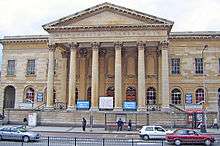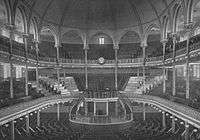Metropolitan Tabernacle
The Metropolitan Tabernacle is a large Independent Reformed Baptist church in the Elephant and Castle in London. It was the largest non-conformist church of its day in 1861.[1] The Tabernacle Fellowship have been worshipping together since 1650. Its first pastor was William Rider; other notable pastors and preachers include Benjamin Keach, Dr. John Gill, Dr. John Rippon, and C. H. Spurgeon. The Tabernacle still worships and holds to its Biblical foundations and principles under its present pastor, Dr. Peter Masters.[2][3][4]
| Metropolitan Tabernacle | |
|---|---|
 2004 photo of the Metropolitan Tabernacle | |
| Location | Elephant and Castle, London |
| Country | United Kingdom |
| Denomination | Independent Reformed Baptist |
| Website | http://www.metropolitantabernacle.org/ |
| History | |
| Founded | 1650 |
| Founder(s) | William Rider |
| Clergy | |
| Pastor(s) | Dr Peter Masters, Assistant Pastor Ibrahim Ag Mohamed |
History
The Tabernacle fellowship dates back to 1650, when the English Parliament banned independent Christian organisations from meeting together. This congregation braved persecution until 1688, when the Baptists were once again allowed to worship in freedom. At this point, the group built their first chapel, in the Tower Bridge area.[5]
In 1720, Dr. John Gill became pastor and served for 51 years. In 1771, Dr. John Rippon became pastor and served for 63 years. During these times, the church experienced great growth and became one of the largest congregations in the country. Afterwards decline set in and by 1850 the congregation was small.[6]
In 1854, the most famous of all the pastors at the Metropolitan Tabernacle started serving at the youthful age of 20. His name was Charles Haddon Spurgeon, and he quickly became the most popular British preacher of his day. The church at the beginning of Spurgeon's pastorate was situated at New Park Street Chapel, but this soon became so full that services had to be held in hired halls such as the Surrey Gardens Music Hall.[6]
During Spurgeon's ministry, it was decided that the church should move permanently to larger premises. The location chosen was the Elephant and Castle, a prominent location near the River Thames in South London, partly because it was thought to be the site of the burning of the Southwark Martyrs. The building with a 6,000-seat auditorium, designed by William Willmer Pocock, was finished in 1861 and dedicated on March 18.[7]
In 1881, the church had 5,500 members. [8]
Spurgeon also founded a college for preachers (now Spurgeon's College) and church workers and orphanages for girls and boys, and wrote many Christian books which are still in print today.[9]

In 1887, the church left the Baptist Union because of the widening influence of theological liberalism within the Union. Spurgeon was adamant that the church would not "downgrade" the faith as he believed other baptist churches were doing.[10]
At the end of 1891, membership was given as 5,311. Spurgeon served for 38 years and died in 1892.[2]
The original building was burned down in 1898, leaving just the front portico and basement intact, before the rebuilt church was destroyed again in 1941 during the German bombing of London in World War II. Once again, the portico and basement survived and in 1957 the Tabernacle was rebuilt to a new but much smaller design accommodating surviving original features.[5]
The war led to the Tabernacle fellowship being greatly diminished as few members of the old congregation were able to return to heavily blitzed central London. It rejoined the Baptist union in 1955. By 1970 the congregation had fallen to the point where it occupied only a few pews. It left the Baptist union again on 22 February 1971, just after Dr. Peter Masters became the pastor, over the same issues as under Spurgeon in 1887.[11] Numbers greatly increased and this gave rise to the full church and galleries of today, together with numerous professions of faith. It hosts an annual School of Theology, runs a part-time Seminary for pastors, has five Sunday schools,[12] and provides free video and audio downloads, along with live-streaming of services.[13] The current assistant pastor at the Tabernacle is Ibrahim Ag Mohamed, originally of Mali.[14]
London Metropolitan Tabernacle School of Theology
Probably one of the largest reformed Christian conferences in the UK, gathering people from around the world, that still takes place today. Many pastors, Christian workers and church officers attend, and younger people seeking a more biblical and committed style of Christian life and service.[15]
Church Basic Policies
The Metropolitan Tabernacle is an independent reformed Baptist church. The following seven points show the key biblical policies followed, laid down by forebears, such as C. H. Spurgeon.[2][3][4]
- Doctrines of grace, commonly called 'Calvinistic'.
- Free offer of the Gospel
- Traditional worship
- Working church
- Biblical separation
- The Prayer meeting
- Wider ministries.[16]
Pastors both past & present
- William Rider, c. 1653–c. 65 (12 years)
- Benjamin Keach, 1668–1704 (36 years)
- Benjamin Stinton, 1704–18 (14 years)
- Dr. John Gill, 1720–71 (51 years)
- Dr. John Rippon, 1773–1836 (63 years)
- Joseph Angus, 1837–39 (2 years)
- James Smith,[17] 1841–50 (8 ½ years)
- William Walters, 1851–53 (2 years)
- Charles Spurgeon, 1854–92 (38 years)
- Arthur Tappan Pierson, 1891–93 (pulpit supply only, not installed as a Pastor – 2 years)
- Thomas Spurgeon, 1893–1908 (15 years)
- Archibald G. Brown, 1908–11 (3 years)
- Dr. Amzi Clarence Dixon, 1911–19 (8 years)
- Harry Tydeman Chilvers,[18] 1919–35 (15 ½ years)
- Dr. W Graham Scroggie, 1938–43 (5 years)
- W G Channon, 1944–49 (5 years)
- Gerald B Griffiths, 1951–54 (3 years)
- Eric W Hayden,[19] 1956–62 (6 years)
- Dennis Pascoe, 1963–69 (6 years)
- Dr. Peter Masters,[20] 1970–present.[2]
See also
Notes
References
- Austin 2007, p. 86.
- Dallimore, Arnold (1985). Spurgeon: A New Biography. Edinburgh: Banner of Truth. ISBN 9780851514512.
- Sheehan, Robert (Jun 1985), Spurgeon and the Modern Church, Phillipsburg NJ: Presbyterian & Reformed Pub Co, ISBN 9780946462056
- Nettles, Tom (21 July 2013). Living By Revealed Truth The Life and Pastoral Theology of Charles Haddon Spurgeon. Ross-shire: Christian Focus Publishing. p. 700. ISBN 9781781911228.
- "Brief History of The Metropolitan Tabernacle". Metropolitan Tabernacle official website. Retrieved 2014-05-24.
- Spurgeon, Charles; Spurgeon, Susannah (compiler); Harrald, Joseph (compiler) (1962). C. H. Spurgeon Autobiography: The Early Years, 1834–1859. Edinburgh: Banner of Truth. ISBN 9780851510767.
- Stephen J. Hunt, Handbook of Megachurches, Brill, Netherlands, 2019, p. 50
- William Cathcart, The Baptist Encyclopedia - Volume 3, The Baptist Standard Bearer, USA, 2001, p. 1095
- "Spurgeon's Writings". The Spurgeon Archive. Archived from the original on 30 June 2013. Retrieved 15 January 2014.
- Poole-Connor, E.J. (1966). Evangelicalism in England. Worthing: Henry E Walter Ltd. p. 223. ISBN 9780854791910.
- Masters, Peter (Dec 2009) [1971], "The doctrine of Biblical separation", The Sword & Trowel, Metropolitan tabernacle.
- "Sunday School Resources | Metropolitant Tabernacle Sunday School materials – Metropolitan Tabernacle". www.metropolitantabernacle.org. Retrieved 2016-02-22.
- "Metropolitan Tabernacle's official website". Retrieved 15 January 2014.
- "School of Theology 2014, Rightly Dividing the Word". Metropolitan Tabernacle, official website. Archived from the original on 2014-06-04. Retrieved 2014-06-04.
- "Metropolitan Tabernacle School of Theology". Metropolitan Tabernacle official website. Retrieved 2014-04-23.
- Church policy (official site), London: Metropolitan Tabernacle.
- Smith, James, OCLC.
- Chilvers, Harry Tydeman, OCLC.
- Hayden, Eric W, OCLC.
- Masters, Peter, OCLC.
Bibliography
- Austin, Alvyn (2007), China’s Millions: The China Inland Mission and Late Qing Society, Grand Rapids, MI: Eerdmans, ISBN 978-0-8028-2975-7.
External links
- Official website
- History of the Metropolitan Tabernacle, official website